Storage Device, Memory Management Method and Program
a storage device and memory management technology, applied in the direction of memory adressing/allocation/relocation, instruments, input/output to record carriers, etc., can solve the problems of insufficient prevention of the occurrence of defective memory blocks, physical discontinuity of normal memory blocks, and suppress the efficiency of accessing flash memory, so as to achieve smooth access to storage areas and suppress the effect of reducing access efficiency
- Summary
- Abstract
- Description
- Claims
- Application Information
AI Technical Summary
Benefits of technology
Problems solved by technology
Method used
Image
Examples
Embodiment Construction
[0055] The following will explain an embodiment of the present invention using a storage system having a flash memory as an example with reference to the drawings.
[0056]FIG. 1 is a block diagram illustrating a physical configuration of a storage system according to an embodiment of the present invention.
[0057] As illustrated in this figure, the storage system includes a memory unit 1 and a computer 2. The memory unit 1 is attached to the computer 2 via an internal bus which computer 2 has. Additionally, for example, as illustrated in FIG. 1, the memory unit 1 and the computer 2 may be incorporated into the same housing.
[0058] The memory unit 1 includes a flash memory 11 and a controller 12.
[0059] The flash memory 11 includes, for example, a storage device such as an EEPROM and a sequencer such as a logic circuit.
[0060] The flash memory 11 stores (writes) data supplied from the computer 2, reads stored data, supplies stored data to the computer 2, and erases stored data in respo...
PUM
 Login to View More
Login to View More Abstract
Description
Claims
Application Information
 Login to View More
Login to View More - R&D
- Intellectual Property
- Life Sciences
- Materials
- Tech Scout
- Unparalleled Data Quality
- Higher Quality Content
- 60% Fewer Hallucinations
Browse by: Latest US Patents, China's latest patents, Technical Efficacy Thesaurus, Application Domain, Technology Topic, Popular Technical Reports.
© 2025 PatSnap. All rights reserved.Legal|Privacy policy|Modern Slavery Act Transparency Statement|Sitemap|About US| Contact US: help@patsnap.com



